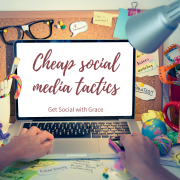Which social media platforms should your business be on?
Every single type of business should be active on social media. While it’s good to be active on all social media platforms, it can be beneficial to focus on just the platforms that can benefit your business the most. But which social media platforms should your business be on?
Start by considering the following two things:
- Who are your target audience?
By defining who your target audience are, you can get an idea of what social media platforms they mostly use.
- What are your overall goals on social media?
Your objectives and goals will help determine not only the social media platforms you choose, but the content you create and more. Here are some of the goals you may want to set:
- Increasing brand awareness and reaching out to new people who might be receptive to your products and services.
- Improving your customer service by being on a platform where customers can reach out with questions and concerns.
- Increasing traffic to your site and boosting sales.
To help you prioritise, I’ve broken down the four best social media platforms for marketing.
1. Facebook
With over 2 billion monthly active users, Facebook is the largest platform by far. It’s good for lead generation, and its advertising tools can be very highly customised to target specific audiences. Facebook is also great for building relationships and turning leads into loyal followers and customers. It’s an all-rounder social media platform.
The only downfall to Facebook is the difficulty in organic growth. It can be worth allocating some budget for advertising.
Target age and gender: 29.7% of all users are ages 25 to 34, and are both men and women. Only 9% of users are under 24.
2. Twitter
Twitter is a hub for trends, news and political rants, all in 280 characters or less. It’s also good for customer service. If your business has the right audience and a big element of customer service, I recommend making this a platform of choice.
The type of content that works best on Twitter are how to articles, lists and quotations. Images perform better than video, but text-based content still reigns as most effective.
Target age and gender: ages 18-29, both men and women.
3. Instagram
Instagram’s a creative and visually engaging platform, heavily targeting a young, female demographic. A picture is really worth a thousand words in this case so if you work in lifestyle, fashion, beauty or food it’s vital to keep your feed current with posts.
Instagram is owned by Facebook, so they have a lot of the same features and ad targeting options, making it a great option for brand awareness and engagement. But if you haven’t got a physical product to sell or don’t work in a visual medium, you might find it tough to make the most of this platform.
Target age and gender: Instagram is mainly used by millennials, and 68% of users are female.
4. LinkedIn
LinkedIn is different from the other platforms listed because its focus is almost entirely on relationships between business to business, rather than business to consumer. For sole traders, building and maintaining connections with past, current and future clients is a big benefit.
LinkedIn is used by 81% of business for product launches compared to 71% using Twitter and 54% using Facebook. If your business is B2B focused, you could try experimenting with LinkedIn ads to boost lead generation and referral traffic.
Target age and gender: Ages 25-45, both men and women.







Trackbacks & Pingbacks
[…] If the agency answers “yes”, this could be a warning flag. Not every social media platform is right for all businesses. Get more of an idea here of which platforms your business should be on. […]
[…] The golden rule of marketing: be where your customers are. With social media, you need to be active on the social media platforms that your target customers use. Chances are, they’re on more than one. To get an idea on what types of people are on different platforms, take a look at this article. […]
Leave a Reply
Want to join the discussion?Feel free to contribute!